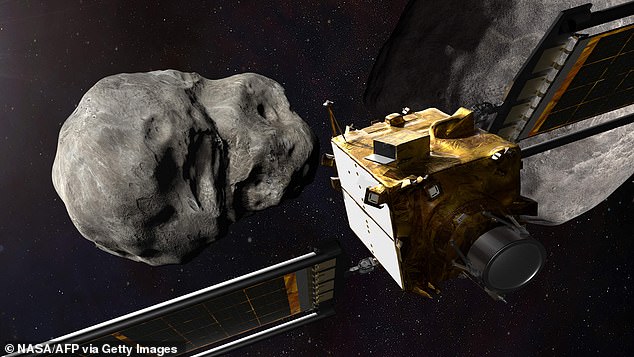Scientists devise a way to save Earth from a catastrophic asteroid impact – by destroying it with nuclear weapons
They are already used to diagnose a wide range of medical problems.
According to researchers, X-rays could also save the future of humanity.
New research suggests that X-ray pulses could be used to deflect massive asteroids on a collision course with Earth.
Laboratory tests show that they work by vaporizing the surface of an asteroid – turning it into a gas – and thereby changing its orbit.
According to experts, this technology could potentially be used for future planetary defense missions, to deflect comets and asteroids whose expected orbits bring them a little too close.
Scientists have discovered a new way to save Earth from a catastrophic asteroid impact: by using X-ray pulses to vaporize the incoming space rock
A team from Sandia National Laboratories in Albuquerque, New Mexico, used X-rays from a nuclear bomb to examine two small fake asteroids in a vacuum — similar to the conditions in space.
In both experiments, they observed that the pulses heated the asteroids’ surfaces, creating a plume of vapor that changed their momentum and orbit.
The researchers then scaled up these measurements to perform simulations with larger rocks.
They suggest that asteroids up to 4 km in diameter flying towards Earth could be deflected using this strategy.
Writing in the diary Physics They said: ‘Asteroid impacts are among the many natural disasters that civilization faces.
Although most asteroids bypass Earth or cause little damage, the largest collisions have caused regional devastation and even the elimination of habitable climates.
“Although rare, eliminating devastating effects has become a national priority.”
They pointed to a recent test conducted by NASA in which a spacecraft was used to hit an asteroid and change its trajectory.

This illustration shows NASA’s DART spacecraft approaching the Dimorphos asteroid before intercepting it and deflecting it away from Earth.
Although this method is effective, it is also expensive and requires a lot of time and preparation.
“NASA’s technology demonstration mission, known as the Double Asteroid Redirection Test (DART), to intercept and deflect Dimorphos by colliding a spacecraft with the rocky asteroid was remarkable,” they wrote.
‘However, kinetic impactors may not be an adequate defense against the largest asteroids that can cause global disruption, especially when warning times are short.
‘Here we demonstrate the simulation of deflecting an asteroid with an X-ray pulse.
‘We apply these results to proposed interceptor energies and predict that asteroids up to (about) 4 km in diameter can be disoriented by this mechanism. This is a feasible way to prepare for future planetary defense missions.’
The most famous asteroid impact is undoubtedly that of the Chicxulub asteroid, which hit our planet 66 million years ago and caused the extinction of the dinosaurs.
The asteroid had a diameter of 15 kilometers and hit at a speed of 20 kilometers per second. This created a mountain range around the crater that was higher than the Himalayas. The air was filled with fine dust for 15 years.
